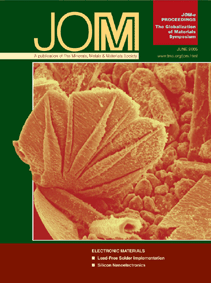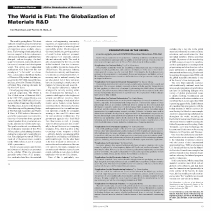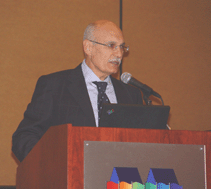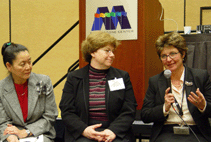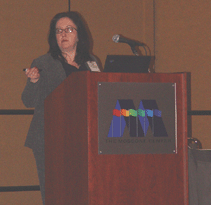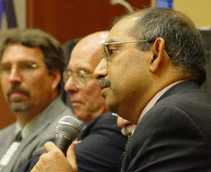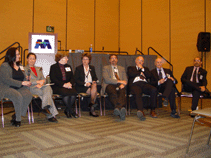 LATEST ISSUE |
||||
TMS QUICK LINKS: |
• TECHNICAL QUESTIONS • NEWS ROOM • ABOUT TMS • SITE MAP • CONTACT US |
JOM QUICK LINKS: |
• COVER GALLERY • CLASSIFIED ADS • SUBJECT INDEXES • AUTHORS KIT • ADVERTISE |
|
| Conference Review: JOM-e: Globalization of Materials | Vol. 57, No. 6, pp. 12-13 |
The World Is Flat:
Globalization of Materials R&D
TONI MARECHAUX AND WARREN H. HUNT, JR.
The world is getting flatter. This is not in the pre-Columbus sense of uninformed ignorance, but rather in the spatial sense of connection across multiple dimensions. The lowering of trade and political barriers coupled with the explosion in information technology capabilities have changed—and are changing—the landscape for everyone, especially those in the materials research and development world.
This spring, two independent publications were titled with this new paradigm of “a flat world” as a focus. First, a presentation that Diran Apelian of Worcester Polytechnic Institute proposed for the 2005 TMS Annual Meeting, and later, a book by Thomas Friedman, a Pulitzer Prize-winning columnist for the New York Times.
Cleverly appropriating Apelian’s title, a special symposium, The World is Flat: Globalization of Materials R&D, at the 2005 TMS Annual Meeting was sponsored by the TMS Public and Governmental Affairs Committee. Organized by Toni Marechaux, director of the Board on Manufacturing and Engineering Design at the National Academies and Warren H. Hunt, Jr., TMS technical director, the goal of the symposium was to provide a diversity of viewpoints from a group of invited speakers from government, academia, and industry on this timely topic. That goal was achieved, as evidenced by the enthusiastic response of the 50 to 100 attendees and stimulating discussion during the symposium’s roundtable portion. You can judge for yourself. TMS has made all of the presentations available on the TMS web site as part of a special JOM-e presentation. Specific session speakers and the titles and abstracts of their talks are presented in the sidebar. While the presenters generally spoke from a U.S. perspective, each articulated how the materials science and engineering community, regardless of organizational interest or technical discipline, is increasingly and unavoidably global. Manifestations of this trend include the growing numbers of non-U.S.-born technical personnel who populate U.S. corporate, national lab, and university staffs.
The trend is also characterized by the low-cost but skilled technical labor that is increasingly available beyond the shores of the United States. The aerospace industry, the electronics industry, and the automotive industry are all important to the U.S. economy and to national security, but are also global. All of these industries have an increasingly complex array of partners for production and research. The speakers addressed a variety of strategies for not only working within this environment but thriving in it. A particular challenge includes heightened security and defense concerns, which restrict the exchange of technical information across borders (some borders more than others). The increased scrutiny and requirements for visas and immigration represent a hurdle for companies wanting to hire non-U.S. citizens and for open academic collaboration. The government agencies that fund R & D face these issues as well. A pressing issue for defense programs may eventually be the pull between two competing strategies. First, there is a drive to buy everything—from weapons to R&D —globally, thereby encouraging global competition and leading to efficiencies and breakthroughs. On the other hand is the drive to spend tax dollars at U.S. universities and manufacturers. One current upshot is that many companies do not understand what they can and cannot export, publish, or even share with their employees who are not U.S. citizens. None of this is particularly new. Certainly academic collaboration has been international for many years, and manufacturers have been striving to reach global markets for almost as long. But the trend toward a truly globalized world was set back dramatically by the events of September, 11, 2001. Before this time, there was a general assumption of, if not complete support for, increasing transnational cooperation, technology sharing, and even ownership. A global defense industry (or at least a transAtlantic one) was the vision in many places.
Today, however, the full cooperation of even close allies has become suspect. Discussions abound over what types of materials are “strategic” or “critical”, along with assertions that their production capability should therefore be preserved and protected. Yet at the same time, many of the underlying trends in the way technology now develops and diffuses continue, with no regard for the growing policy gridlock. The dialogue of this symposium comes at a time when the technical community at large is focusing attention on this subject. A number of studies published by the National Academies (Sciences, Engineering, Medicine) have addressed these issues, including a just-published report by the National Materials Advisory Board titled Globalization of Materials R&D. While a significant and understandable focus of the symposium’s attention was on the impact of globalization on business, industry, and government, the topic is on the minds of the leadership of professional and technical societies as well.
TMS recognizes the importance of this issue, and TMS Vice President Brajendra Mishra closed the formal session presentations by discussing the role of professional societies in an increasingly global world. The materials societies play a key role in the global materials community in communication, education, and coordination for their individual members. Mishra noted that roughly 30 percent of the membership of TMS consists of non-U.S. members, and that participation in meetings (both programming and attendance) as well as paper publication in journals is highly international and increasing. He also said broadening the engagement of TMS with the global materials community is one of the Society’s four strategic goals. The role that materials societies with traditionally national roots but increasingly international memberships can have in facilitating dialogue on a variety of global professional issues is clearly evolving. Coordination and collaboration with other societies on a worldwide basis is one aspect that TMS is pursuing aggressively. Establishment of e-membership arrangements with the Indian Institute of Metals and the Chinese Society for Metals is one example. Another is programming collaborations throughout the world, including the Pacific Rim International Conference on Advanced Materials and Processing, the Global Symposium on Recycling, Waste Treatment, and Clean Technology, the International Conference on Processing Materials for Properties, and Thermec. One issue that professional and technical societies must continue to address is the balancing of national concerns with the interest of their international membership base. TMS involvement in U.S.-based activities such as the Materials Societies Council is an example of an activity focused on key domestic issues such as advocacy for federal programs and K-14 education. In his conclusion, Mishra stated that materials societies must think and act globally to be effective, and that there must be interaction and partnership in every activity of the Society. In many ways, this is a model across all constituencies in the “flat” world that we live and work in now and will in the future. Toni Marechaux is director of the Board on Manufacturing and Engineering Design at the National Academies. Warren H. Hunt, Jr., is technical director for TMS. For more information, contact Toni Marechaux, the National Academies Board of Manufacturing and Engineering Design, 500 Fifth St. NW, Washington, DC 20001; (202) 334-2589; e-mail tmarecha@nas.edu. |

